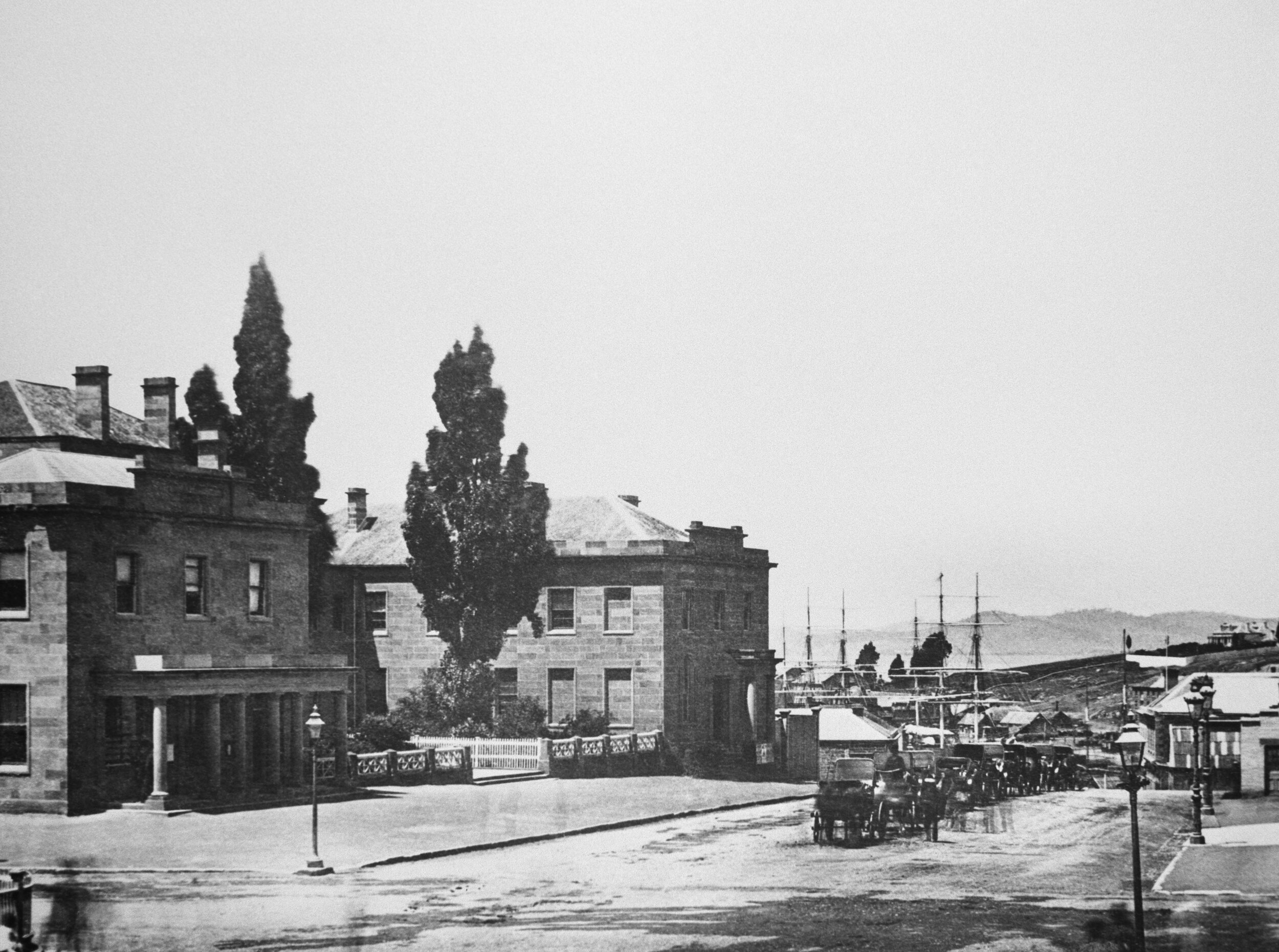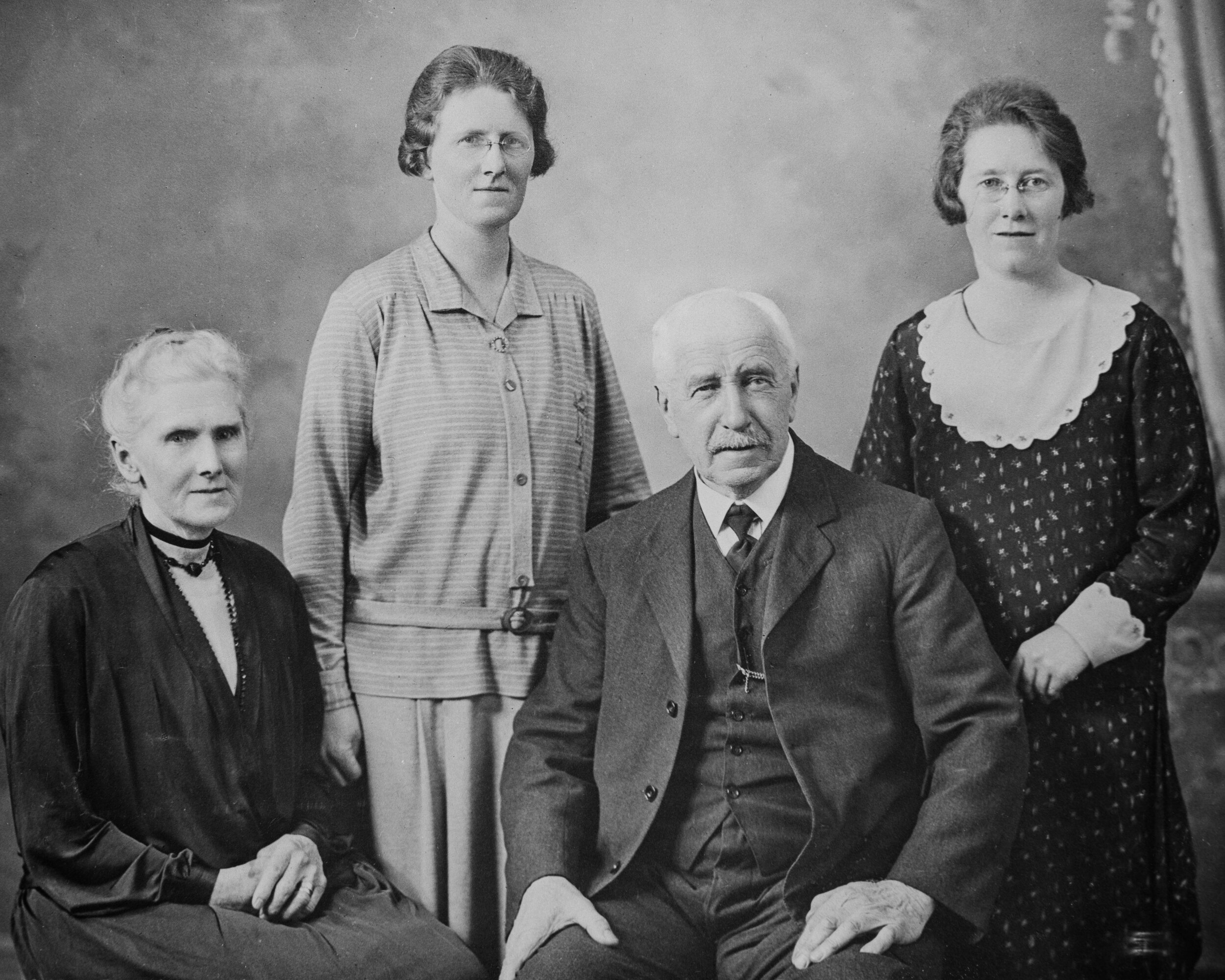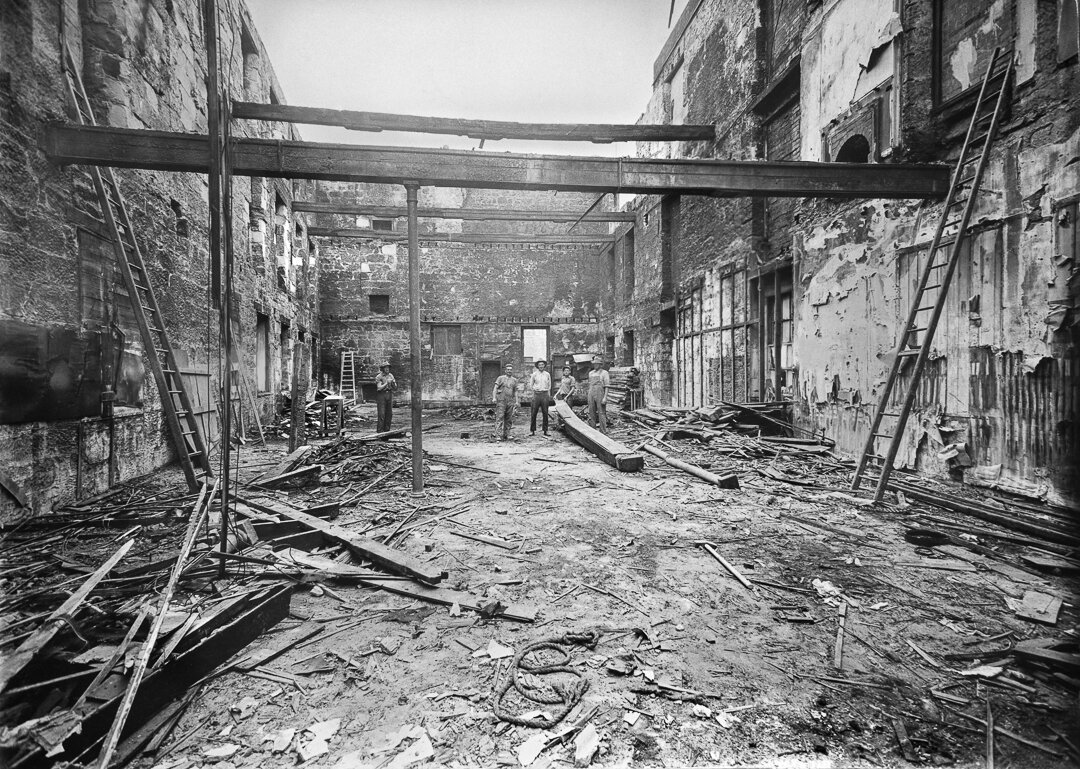Episode 301 - What’s left of Beattie’s Studio ?
G’day, I’m John Stephenson and welcome to episode 301 of Forgotten Tasmania.
From the 1840s, photographers started documenting Van Diemen's Land. In 1879, Scottish immigrant John Watt Beattie said Tasmania was so beautiful it made his soul sing. He kick-started the Tasmanian tourism industry and explored the island extensively, going where no one had photographed before, adding to the record of the people, places and events. When he died in 1930, they said his collection was destroyed. It's been largely forgotten ever since.
There’s some debate if this photo is the oldest ever taken in Tasmania, but I believe the one below is older. Its from the National Library of Australia in Canberra and I’ve seen it with my own eyes. It’s haunting. 1839 right there in front of you.
I inherited photos by Beattie and other Tasmanian photographers. The collection had been stored under the house I grew up in, but I had no idea what was in those wooden shoe boxes until my father passed away and my brother asked me to digitise the old photos.
I found an incredible collection. Every photo gives a feeling of amazement, something beautiful, remarkable, or unfamiliar.
The people of Hobart may remember Beattie’s Studio, but there’s more to the story than Santa photos, portraits and weddings. The history of Beattie’s Studio is more than Mr Beattie. He gave his name to the business, but it’s built on a legacy dating back much further.
During the 1950-1990 era, Beattie’s Studio was a very popular place to have your photos done, especially weddings and portraits. This one is from my Dad’s portfolio that he made in the years before his death, to show family and friends what he had done and what he was proud of. I think this is a Miss Tasmania quest entrant.
Roald Amundsen was the first man to the South Pole in 1911 and Beattie developed the precious photos for him. Amundsen sent a telegram to the King of Norway from the Hobart GPO, there is a plaque on the ground to commemorate that telegram. I do have a photo, but I cant find it yet. Amundsen also traversed the North West Passage successfully, which former Tasmanian Governor Sir John Franklin had died attempting earlier in 1845. Franklin’s remains were only found recently in 2016 and there is a TV series about that voyage, called The Terror.
The first photographs used small pieces of highly polished copper that had been silver plated and treated with chemicals to make them sensitive to light. Invented by Frenchman Nicephore Niepce, who also invented the internal combustion engine, the process was perfected by Louise Daguerre and patented in 1839 as the Daguerreotype. Only one year later, in 1840, Daguerreotype photography arrived in Van Diemen’s Land as an official communication to Lieutenant Governor Sir John Franklin.
Thomas Bock was a talented painter who is remembered for his portraits of Tasmanian aboriginal people, made in the 1830s, before photography. These paintings were made by studying the actual living people. It is believed that the subjects sat for Bock and the portraits are quite true to life.
Thomas was a convict transported to VDL for administering herbs with the intent to cause miscarriage. My guess is, that means he was something of a chemist or pharmacist.
These Bock paintings were in the UK, then returned to Australia recently to be shown in Hobart and Canberra. One of them is of Mathinna, an aboriginal girl adopted by Sir John Franklin. They are very special.
Skills you needed to be able to use the Daguerreotype photography kit; a wooden box supplied with various equipment, bottles of chemicals, plates and instructions. It was very much a do-it-yourself affair.
The directory of Tasmanian Photographers 1840-1940 by Chris Long lists Thomas Bock making photos in 1848, working from his studio at 22 Campbell Street. And there’s a Daguerreotype price list for a Mr Bock of the same address. Although Bock’s entry in the Australian Dictionary of Biography makes no mention of this and credits Thomas’s son Alfred Bock as being the photographer of the family.
Thomas was indeed succeeded by Alfred, who was a successful portrait photographer. He is noted for hand colouring his photographs but many of them look like paintings because he was a bit heavy handed with the colour.
Charles Woolley photographed the indigenous people, controversially known as The Last Tasmanians in 1866. These photographs are incredibly significant today.
William Lanne was a well known aboriginal man and very significant historical figure. His corpse was desecrated by William Crowther. There is a statue of Crowther in Franklin Square Hobart and this year it has been reinterpreted by local aboriginal artists to include those dark facts as part of truth telling. I personally would like to see a statue of Lanne (if culturally acceptable) replace that of Crowther. I met Crowther’s grandson (Sir William Crowther 1887-1981) at the State Library in 1979 and talked with him at some length, I wish I had made notes or a recording, alas not.
Samuel Clifford is remembered for his photographs of Port Arthur and his stereoscopic photo cards. In 1878 he sold his studio to the Anson brothers.
There were three brothers Henry, Richard and Joshua. In 1882 they employed John Watt Beattie and in 1891 he bought out the brothers and changed the name to Beattie's Studio.
Beattie had a long and distinguished career which is covered in another episode.
He sold some of his collection to the museum in Launceston. Beattie died in 1930 and some more was sold to the museum in Hobart, but thousands of negatives remained.
A man called Frank Cane had the studio in 1933 and there was a fire. Beattie’s cousin and chief publicist, Jack Cato, wrote that everything was destroyed. I disagree with that myth.
Beattie’s Studio operated from McGuffey’s in Collins Street until 1934 when they re-opened in Murray Street.
In 1928, Arch Stephenson had been lured from Launceston by John Watt Beattie. I think Arch liked Beattie's work so much that he got a desire to do landscape photography.
Arch riding, his wife Florence and son Alberto Archibald (my father).
In 1934 Arch bought Beattie’s Studio. He was my grandfather and Beattie’s has been in my family ever since.
Arch was joined by his teenage son, Alberto, who became a portrait photographer. He was my father and he told me he studied lighting and composition and other skills for the photographic arts and modelled his work on the paintings of Rembrandt. Dad won many awards for his photography and was quite well known in his day. He photographed so many people under the name Beattie’s Studio, that many thought he was John Watt Beattie and referred to him as Mr Beattie.
In 1988 my father opened the Beattie's Studio photographic museum. In 1993 he took the collection to his house and it was shown there for a few years.
Dad brought in my brother William (Bill) and he worked in the studio too.
Bill was really the one who saw the value in the historic collection and he’s the one who preserved and spent the most time working on it.
Bill was also noted for his wedding photography and he pretty much took over the business when Dad was looking to retire.
This is my photographer’s (Jim Palfreyman) mother Jen on her wedding day to Jim’s dad.
He was also a picture framer, another aspect of the studio that’s often ignored.
This photo taken by our dad.
Dad passed away in 2013, and my brother said he thought we should “put these photos on the internet” and I stuck my hand up for that job.
I had spent the summer of my 16th birthday working at Beattie's but chose a career in computers.
Yes, I was 16 once and looked even more dorky than I do now!
Bill spent 8 years teaching me about the historic photos in the collection. How to print them, how to care for them and I found a love for them.
The Korongee Dementia Village Nursing Home in Gelnorchy Tasmania has an exhibition of Beattie’s photos.
William passed away in March of 2021 and the studio is now owned solely by me. I get to write the history from now on.
Sorell Antique Centre has Beattie’s photos for sale.
I use digital techniques from my decades of experience with computers. I’m going through Bill’s things and I’ve already found many more photos and other treasures that I didn’t know about. There’s enough material to keep the documentary series going for years. And I love making it and sharing those stories with you.
Hobart Town Tea Rooms has Beattie’s photos for sale.
What did Beattie’s Studio actually do, back in the day? Well, in the 1800s a photographer did everything. They manufactured and sold photographic film. They took photographs, and not just one type of subject matter like todays specialist photographers; landscape, portrait, headshot, commercial, artist, fashion, paparazzi etc. A photographer photographed anything and everything from wilderness to weddings.
Betty Roberts Beattie’s Studio colourist in the 1960’s
AA (Bill) and Jean Stephenson on their wedding day. My parents.
Sue Hickey Miss Tasmania 1979 photographed by Dad. Sue later went on to start a successful business called Slick Promotions, became Lord Mayor of Hobart and then was elected to the House of Assembly in state parliament. Many of the Miss Tasmania Quest winners are trail blazers, highly successful business women and they remain close friends. I believe they still meet regularly to this day.
First AMP building Hobart.
First National Mutual building Hobart, inside and out.
Beattie’s Studio was good at adopting new technology. From the 1850s to the 1950s, the technology of photography evolved rapidly.
The material in the collection is a great sample of the different types of technology that make up the history of photography.
Daguerreotypes – The first commercially patented system for storing an image. These early photos degrade if left exposed to light and were presented in a folding frame that was kept closed when not being viewed.
Glass plates – A massive leap forward in technology using a silver gelatine process to save the image on glass. Initially large plates of glass were used, later the sizes reduced. The quality of the larger plates is stunning.
Sheet film – the next generation of large format film used a flexible plastic to support the gelatine silver image, retaining the quality but being much lighter and less fragile than glass. Most of the Beattie’s Studio portraits are on sheet film.
Stereoscopes – two photos taken together that give a 3D effect.
Glass lantern slides – Projected on a screen using a flame as a light source, these photographic slides were immensely popular, especially in Britain where they were hungry for images of their distant colony, Tasmania.
35mm slides – a progression from glass slides, these were very popular because they were available in very accurate vivid colour.
Panorama – using a clockwork mechanism to advance the film and pan the camera, these captured a 180 degree view on film 36 inches long and 9 1/4 inches high. The quality is also excellent, clocking in at over a gigapixel.
As film became smaller and more flexible, roll film could hold multiple photos, and changing the film was easier and quicker.
There’s family photos, corporate groups, sporting clubs, events and parades. We’ve got military, wilderness, vehicles, trains and transport, animals and ships.
As well as Beattie’s material, I restore photos for other people. I’ve reunited several families with photos of their ancestors that were previously lost to fading, mould, or other disasters.
This gentleman is the same age as me!
Ansel Adams said that the negative is like sheet music and the print is the performance of that music. I’ve chosen to perform the negatives in a modern black and white style. When we analysed one of the glass plates, we calculated that there was around 80 megapixels of information hiding in there. With digital photography, I can bring out all that detail and show it to you for the first time.
Darkroom equipment – wooden developing tanks, enlargers, colour meters, dishes and trays.
The Beattie’s Studio Collection has photos dating as far back as the 1840s, although most are 1880-1930. Black and white, with some hand coloured, some sepia and a few colour photographs.
My primary story telling is through the photographs. I also re-photograph the scenes to show the passage of time. My footage is modern, colour HD video. I like to be as cinematic as possible and also pay homage to the Beattie photos with a similar style – doing what Mr Beattie might have. He used the new technology of his time – panorama, large format etc. I like to use innovative new cameras like drones, action and 3D cameras. I add music and sound to further enhance the experience. Beattie narrated his lantern slide lectures, so I’ve narrated my videos.
There is no index or historical information with the collection.
I’m putting the history back through the web site and these documentaries. I’m telling the stories again.
So this is my performance of the Beattie’s Studio collection. In these videos I will tell you some of the stories I’ve uncovered. There’s thousands of photos and each one has a forgotten story.
We are Tasmanian, these are our stories, This is Beattie's Forgotten Tasmania.
Links and References
Thomas Bock;
https://adb.anu.edu.au/biography/bock-thomas-1800
William Bryden, 'Bock, Thomas (1790–1855)', Australian Dictionary of Biography, National Centre of Biography, Australian National University, https://adb.anu.edu.au/biography/bock-thomas-1800/text2043, published first in hardcopy 1966, accessed online 27 May 2021.
Photo of Bock;
TAHO ref: AUTAS001131821548J2K
https://www.ikon-gallery.org/event/thomas-bock/
Bock price list
https://stors.tas.gov.au/AUTAS001139594055J2K$init=AUTAS001139594055
Macquarie Street
https://stors.tas.gov.au/AUTAS001131827628J2K$init=AUTAS001131827628
Portrait by Alfred;
https://stors.tas.gov.au/AUTAS001131821548J2K$init=AUTAS001131821548
Rev Peter Campbell. Possibly by Alfred Bock
https://stors.tas.gov.au/TASIMAGES$init=AUTAS001125882043W800
Daguerreotype kit
https://purosol.com/blogs/news/world-photo-day
Music
Deeper than the ocean, Bonnie Grace
https://www.epidemicsound.com/track/gcLhXJgP7U/
Video by Annushka Ahuja from Pexels
Darkroom photographer















































